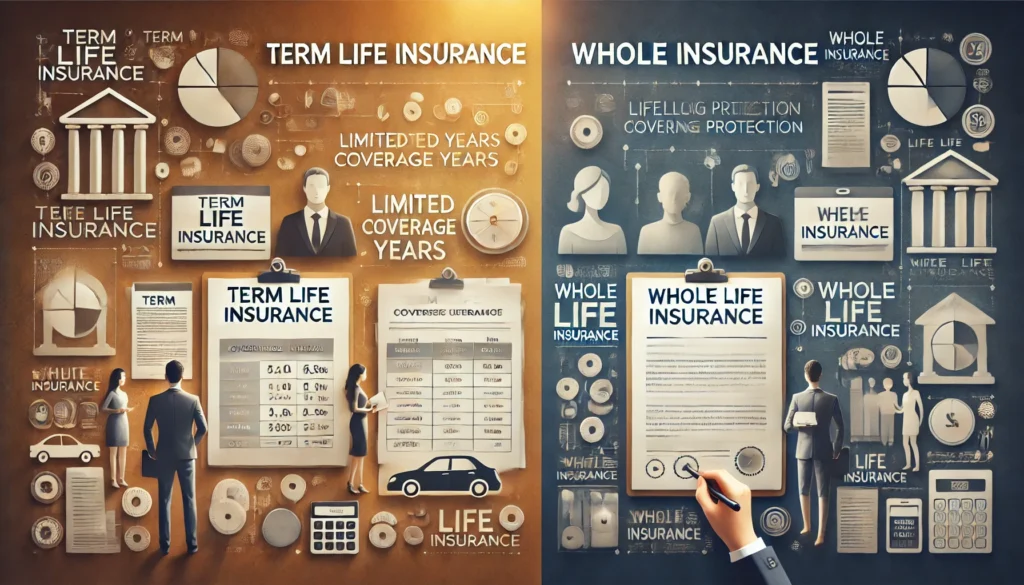- Introduction to Life Insurance in 2024
- The Importance of Life Insurance: Introduce the purpose of life insurance, emphasizing the financial security it provides to policyholders and their loved ones.
- Why Choosing the Right Policy Matters: Discuss how selecting an appropriate life insurance policy aligns with financial planning goals, whether that’s income replacement, debt coverage, or legacy planning.
- Overview of Life Insurance Trends in 2024: Briefly mention recent trends, such as digital-first policies, hybrid options, and an increased focus on wellness incentives and customization.
- Understanding the Basics of Life Insurance
- Types of Life Insurance: Outline the two main types—term and permanent life insurance—and explain the key differences.
- Common Life Insurance Terms: Define essential terms such as premiums, beneficiaries, cash value, riders, and death benefit to help readers understand the terminology used in life insurance policies.
- Factors Affecting Life Insurance Costs: Discuss factors such as age, health, lifestyle, policy type, and coverage amount, which influence premium costs.
- Policy #1: Term Life Insurance
- What is Term Life Insurance?: Define term life insurance as a policy that provides coverage for a set period, usually 10, 20, or 30 years, with affordable premiums and no cash value accumulation.
- Pros of Term Life Insurance: Highlight the affordability of term policies, making them accessible for young families, and the straightforward structure that ensures a death benefit if the policyholder passes away during the term.
- Cons of Term Life Insurance: Explain the downside—term policies do not accumulate cash value and typically expire with no payout if the policyholder outlives the term.
- Who Should Consider Term Life Insurance?: Describe how term life is ideal for those looking for affordable coverage during peak financial responsibilities, such as raising children or paying off a mortgage.
- Tips for Choosing a Term Life Policy: Provide tips on selecting an appropriate term length and coverage amount based on personal financial goals.
- Policy #2: Whole Life Insurance
- What is Whole Life Insurance?: Define whole life insurance as a type of permanent policy offering lifelong coverage with a guaranteed death benefit and cash value component.
- Pros of Whole Life Insurance: Explain the benefits of whole life policies, including lifetime coverage, predictable premiums, and cash value that grows over time, which can be borrowed against or withdrawn.
- Cons of Whole Life Insurance: Outline the downsides, such as higher premiums compared to term life, and the potential for slower cash value growth in the initial years.
- Who Should Consider Whole Life Insurance?: Highlight how whole life may suit individuals focused on legacy planning, wealth transfer, or those who want guaranteed lifelong coverage.
- Tips for Choosing a Whole Life Policy: Provide guidance on choosing a reputable insurer with a strong financial background and understanding policy dividends, which some insurers offer to whole life policyholders.
- Policy #3: Universal Life Insurance
- What is Universal Life Insurance?: Define universal life insurance as a flexible permanent policy that allows policyholders to adjust premiums and death benefits, with cash value that earns interest based on market rates.
- Pros of Universal Life Insurance: Emphasize the flexibility in premium payments and death benefits, making it adaptable to changing financial circumstances, and potential cash value growth.
- Cons of Universal Life Insurance: Discuss the complexities involved, including fluctuating cash value growth and the potential for higher premiums if the cash value does not perform well.
- Who Should Consider Universal Life Insurance?: Describe how universal life suits those who want long-term coverage but may need flexibility in payments or death benefits.
- Tips for Managing a Universal Life Policy: Provide tips on monitoring cash value growth and adjusting premium payments to avoid lapsing, as well as the importance of regular policy reviews with an insurance professional.
- Policy #4: Variable Life Insurance
- What is Variable Life Insurance?: Define variable life insurance as a type of permanent life insurance that includes investment options within the policy’s cash value, allowing for potential growth based on market performance.
- Pros of Variable Life Insurance: Explain the growth potential of cash value based on investment performance, making it appealing for those comfortable with market risks and seeking investment opportunities within their insurance policy.
- Cons of Variable Life Insurance: Highlight the risk involved, as the cash value can fluctuate with market changes, leading to potential loss of value, and the fees associated with managing investments within the policy.
- Who Should Consider Variable Life Insurance?: Describe how variable life may suit individuals with a higher risk tolerance who want an investment component in their insurance plan.
- Tips for Managing a Variable Life Policy: Provide tips on monitoring investments closely, understanding policy fees, and consulting a financial advisor to maximize returns while managing risk.
- Policy #5: Indexed Universal Life Insurance (IUL)
- What is Indexed Universal Life Insurance?: Define IUL as a type of universal life insurance where the cash value is tied to a stock market index (e.g., S&P 500), offering the potential for higher returns while capping losses.
- Pros of Indexed Universal Life Insurance: Highlight the potential for cash value growth tied to market indices with a cap and floor, allowing policyholders to participate in market gains with some protection from losses.
- Cons of Indexed Universal Life Insurance: Explain the complexity of IUL policies, including caps on gains, fees, and the need for careful management to avoid policy lapses.
- Who Should Consider Indexed Universal Life Insurance?: Describe how IUL may suit those interested in both life insurance coverage and moderate investment growth, appealing to individuals with a moderate risk tolerance.
- Tips for Choosing an IUL Policy: Offer guidance on selecting policies with favorable caps and floors, understanding participation rates, and regularly reviewing policy performance with an insurance advisor.
- Comparing the Five Policies: Which is Right for You?
- Assessing Your Coverage Needs: Guide readers on assessing their life insurance needs, considering factors like family dependents, debt, and income replacement.
- Weighing Premium Affordability vs. Benefits: Discuss how to balance the affordability of premiums with the benefits offered by each policy type, especially for those on a budget or with variable incomes.
- Considering Cash Value Growth Potential: Explain the significance of cash value growth for those interested in policies like whole life, universal life, or indexed life, and how this can affect long-term financial planning.
- Thinking About Flexibility Needs: Advise readers on whether they need flexible premiums and death benefits, as universal and indexed universal policies offer more adaptability compared to term and whole life.
- Key Factors to Consider Before Buying Life Insurance
- Age and Health: Explain how age and health impact premiums, with younger, healthier individuals typically securing lower rates, making early purchase advantageous.
- Financial Goals: Encourage readers to clarify their financial goals—such as wealth transfer, income replacement, or legacy building—to align with the policy best suited to these goals.
- Family and Dependents: Discuss the importance of considering family needs, including coverage amounts that would adequately support dependents in the event of the policyholder’s death.
- Longevity and Long-Term Care Considerations: Mention the potential for life insurance to serve as part of long-term care planning, particularly for those concerned about covering healthcare costs later in life.
- Real-Life Scenarios: Choosing the Right Policy for Different Stages of Life
- Young Adults Starting Out: Describe a scenario where a young adult with a limited budget chooses term life insurance for affordable coverage during early career years.
- Growing Families: Share a case of a family opting for a whole life policy to secure lifelong protection and build cash value for future needs, such as children’s education.
- Established Professionals Seeking Investment Opportunities: Discuss a scenario where a professional with disposable income chooses a variable life policy to incorporate investment growth into their insurance.
- Individuals Nearing Retirement: Present a situation where a pre-retiree chooses universal or indexed universal life insurance for flexible premiums and cash value growth that can supplement retirement income.
- Tips for Maximizing the Benefits of Your Life Insurance Policy
- Regular Policy Reviews: Recommend conducting annual policy reviews to adjust coverage, ensure performance aligns with goals, and add or remove riders as needed.
- Using Riders for Additional Coverage: Explain the use of riders, such as accelerated death benefits, long-term care, or critical illness riders, to enhance policy coverage.
- Borrowing Against Cash Value: Describe how whole and universal life policyholders can borrow against their policy’s cash value, and explain considerations for paying back loans to avoid affecting the death benefit.
- Tax Advantages of Life Insurance: Highlight the tax advantages of life insurance, including tax-free death benefits and tax-deferred cash value growth.
- How to Choose a Reliable Insurance Provider
- Financial Stability and Ratings: Emphasize the importance of choosing a provider with strong financial ratings from agencies like A.M. Best, as it reflects the company’s ability to fulfill claims.
- Customer Service and Claims Processing: Discuss why good customer service and efficient claims handling are critical, especially for beneficiaries.
- Policy Customization Options: Explain the benefit of selecting insurers who offer customizable policies and a wide range of riders, allowing policyholders to tailor coverage to their needs.
- Reading Reviews and Getting Referrals: Suggest reading customer reviews and asking for recommendations from trusted sources to ensure the insurer is reputable.
14. Common Mistakes to Avoid When Choosing Life Insurance
- Underestimating Coverage Needs: Explain how underestimating the amount of coverage can leave dependents financially vulnerable. Recommend using income-replacement formulas to determine an adequate death benefit.
- Relying Only on Employer-Provided Life Insurance: Discuss the limitations of relying solely on employer-provided insurance, which may not offer enough coverage and often doesn’t transfer when changing jobs.
- Choosing the Wrong Type of Policy: Highlight why choosing the wrong policy type—such as opting for term when whole life is needed for estate planning—can lead to long-term financial issues. Suggest consulting a financial advisor.
- Ignoring Additional Benefits and Riders: Explain how ignoring optional riders like accelerated death benefit, waiver of premium, or long-term care riders can limit the usefulness of a policy.
- Not Reviewing Policies Regularly: Emphasize the importance of regularly reviewing policies to ensure coverage still aligns with current life circumstances, such as marriage, the birth of a child, or retirement.
15. Maximizing Tax Advantages with Life Insurance
- Tax-Free Death Benefits: Describe how life insurance provides tax-free death benefits to beneficiaries, which can be a powerful wealth-transfer tool.
- Tax-Deferred Cash Value Growth: Explain how whole, universal, and indexed universal life policies allow cash value to grow tax-deferred, making them useful for individuals focused on long-term financial growth.
- Using Life Insurance for Estate Planning: For high-net-worth individuals, discuss using life insurance for estate planning to cover estate taxes, allowing heirs to receive their full inheritance without needing to liquidate assets.
- Creating a Life Insurance Trust: Describe how a life insurance trust can shield the policy’s death benefit from estate taxes and ensure funds are distributed as intended.
- Tax Advantages of Health-Related Riders: Mention tax benefits that may apply when using health-related riders, like accelerated death benefit for chronic or terminal illnesses.
16. Life Insurance for Different Life Stages
- Young Adults and Single Professionals: Discuss how young adults can benefit from affordable term policies for income replacement and debt coverage, such as student loans.
- New Families and Homeowners: Describe the benefits of term or whole life insurance for young families who need to protect against income loss and mortgage debt.
- Middle-Aged Professionals and Business Owners: Explain why universal or variable life policies may suit individuals looking for coverage that can also serve as an investment vehicle.
- Retirees and Seniors: Outline how whole life or final expense policies can be beneficial for covering end-of-life costs or providing an inheritance, especially for those who may no longer need high-value coverage.
- High-Net-Worth Individuals: Explain how indexed universal or whole life insurance with cash value can support estate planning goals and provide flexibility for managing assets.
17. How to Get the Best Rates on Life Insurance
- Shop Around and Compare Quotes: Emphasize the importance of comparing quotes from multiple insurers to find competitive rates. Online comparison tools can streamline this process.
- Purchase Life Insurance Early: Highlight how younger and healthier individuals typically secure the best rates, encouraging early purchase.
- Improve Health Factors: Describe how policyholders can improve their rates by maintaining a healthy lifestyle, including quitting smoking, regular exercise, and managing chronic health issues.
- Consider a Medical Exam: Mention that undergoing a medical exam often leads to better rates than no-exam policies, as insurers can more accurately assess health risks.
- Choose the Right Coverage Amount and Term: Explain how selecting the right coverage and term length impacts premiums, and how adjusting these can help find the most affordable option.
18. Frequently Asked Questions About Life Insurance
- What is the Difference Between Term and Whole Life Insurance?: Provide a concise answer comparing the temporary nature of term insurance with the permanent coverage and cash value benefits of whole life insurance.
- How Much Life Insurance Coverage Do I Need?: Suggest a guideline for coverage amount, such as 5-10 times annual income, and discuss using online calculators or consulting advisors.
- Can I Change My Life Insurance Policy Later?: Explain options for changing policies, such as converting term to whole life or increasing coverage with universal policies.
- What Happens if I Miss a Payment?: Describe typical grace periods and the potential for policy lapse, depending on policy type and insurer.
- Is Life Insurance Tax Deductible?: Clarify that life insurance premiums are generally not tax-deductible, though certain policies may offer tax advantages.
Conclusion
In 2024, selecting the right life insurance policy is more accessible and customizable than ever, with options to fit a wide range of needs, financial goals, and risk tolerance. By understanding the unique features, benefits, and limitations of each policy type—term life, whole life, universal life, variable life, and indexed universal life—individuals can choose the coverage that best suits their stage of life and financial objectives.
Life insurance provides more than just a death benefit; it can support wealth-building goals, offer tax advantages, and serve as a vital component in estate planning. Whether you’re a young professional seeking affordable term coverage, a growing family looking for lasting protection, or a high-net-worth individual focused on legacy planning, there’s a policy that aligns with your goals.
As with any financial decision, it’s essential to carefully evaluate personal needs, consult with licensed professionals, and review your life insurance policy regularly to ensure it remains aligned with your evolving life circumstances. By doing so, you can secure financial peace of mind for yourself and your loved ones, knowing that your coverage is both comprehensive and cost-effective.
Ultimately, the right life insurance policy is a powerful tool to protect what matters most, helping you to build, preserve, and transfer wealth with confidence.





